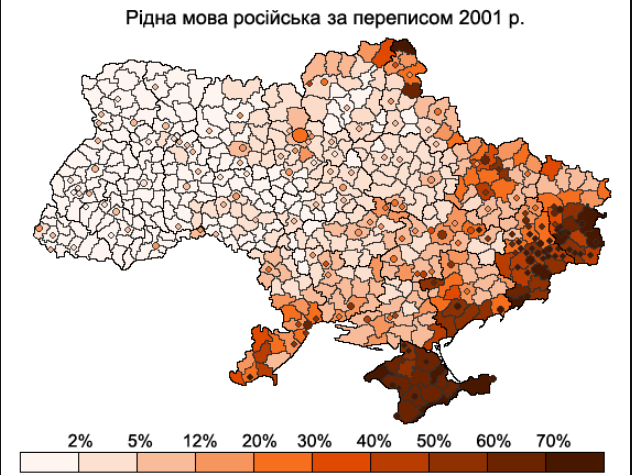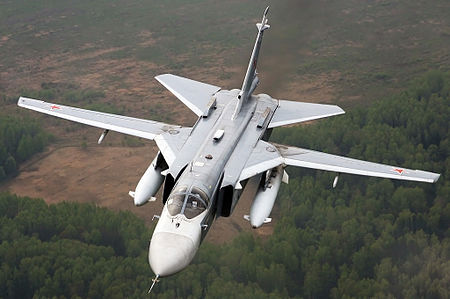The latest from Bakhmut: The situation in the eastern Ukrainian city, where fighting has raged for months, remains "under control," the Ukrainian military said. . . . Russian forces still control access to both Bakhmut and the nearby town of Avdiivka on three sides. They have made marginal gains in recent weeks but have been unable to encircle Ukrainian troops in either place. Most of the eastern front lines have changed little in the first three months of this year.
From CNN.
The map below is from about three and a half months ago and demonstrates the slight gains that Ukrainian forces have made in that time period, mostly west of the Dnipro River near Kherson and just west of Luhansk in the northeast.
Future Prospects
If places where a majority of people claimed Russian as their primary language in 2001 is a good indicator of an equilibrium outcome (which is a plausible assumption), then we would expect some modest additional Ukrainian territorial gains, but probably not for Ukraine to reclaim any significant part of its initial territorial losses from 2014, or a fair share of the additional territory that Russian has gained control of along the Aral Sea.
Ukraine might have a decent shot at regaining half of the reclaiming half of Russia's remaining post-2014 territorial gains (about 5% of its territory), but will likely have a much harder time reclaiming the 7% of its territory secured by Russia in 2014, and another 5% of its territory gains in the last 13 months that is heavily ethnic Russian.
The prospects that Ukraine will regain control of Crimea, in particular, seem dim. And, honestly, the combination of removing the most heavily Russian enclaves from Ukraine and the shift in attitudes towards Russia and the West respectively that the war has engendered, shifts Ukraine from being on a political tightrope between the West and Russia to being solidly in the pro-Western camp. So, covertly, regaining all of Ukraine's territorial losses would actually probably weaken the Ukrainian government.
A Russian Fighter-Bomber Was Shot Down Today
Kyiv said it shot down a Russian Su-24M bomber near Bakhmut this afternoon. CNN cannot independently verify the claim.
This Russian fighter-bomber has a top speed of Mach 1.6, a combat range of 615 km, a crew of two, a 23mm canon, and nine hard points that can carry up to 8,000 kg of bombs or missiles. There were about 1,400 of them produced from 1967-1993 and it entered service in 1974.
Substantial numbers of ex-Soviet Su-24s remain in service with Kazakhstan, Russia, and Ukraine. In 2008, roughly 415 were in service with Russian forces, split 321 with the Russian Air Force and 94 with the Russian Navy. The Russian Air Force will eventually replace the Su-24 with the Sukhoi Su-34.
The Sukhoi Su-24 (NATO reporting name: Fencer) is a supersonic, all-weather tactical bomber developed in the Soviet Union. The aircraft has a variable-sweep wing, twin-engines and a side-by-side seating arrangement for its crew of two. It was the first of the USSR's aircraft to carry an integrated digital navigation/attack system.The SU-24 started development in the early 1960's and entered full production in 1967. Production ceased in 1993. It remains in service with the Russian Air Force, Syrian Air Force, Ukrainian Air Force, Algerian Air Force and various other air forces to which it was exported.
From here.
The F-111 was replaced in USAF service by the F-15E Strike Eagle for medium-range precision strike missions, while the supersonic bomber role has been assumed by the B-1B Lancer.
In the bigger military picture, one of the greatest mysteries of the Ukraine War has been the utterly ineffectual role played by the Russian Air Force. It should have been vastly superior to Ukraine's and secured air superiority in Ukraine at the outset.
But, due to some combination of Ukrainian anti-aircraft weapons Ukrainian fighters defending its airspace, and a Russian Air Force that is a paper tiger without the training, readiness, and resources to operate at anything close to full capacity, this hasn't happened.
Russia has certainly has certainly lost some warplanes, like the latest Russian Su-24 that was shot down today, as has Ukraine.
But the number of planes lost has been nothing remotely approaching the losses of tanks and other personnel and equipment associated with ground forces. Russia has lost a much smaller share of its warplanes than it has of its tanks, armored personnel carriers, troops, logistics vehicles, and artillery batteries, for example.
Russian Aircraft Losses
On paper, on the eve of the Ukraine War, Russia had 427 ground attack fighters like the Su-24 and 185 air superiority fighters, in addition to a small fleet of long range bombers and its naval aviation aircraft (none in the Black Sea fleet, however).
Now, Russia has lost 78 fixed wing aircraft including 12% of its "on paper" fighter aircraft (15 in the last four months) broken down as follows: 15 air superiority fighters, 59 ground attack fighters not including the one shot down today, 2 long range bombers, and one transport plane), 80 helicopters (9 in the last four months) consisting of 18 transport helicopters, 56 attack helicopters, and 6 helicopters of unknown type), 7 combat unmanned aerial vehicles (3 in the last four months), and 198 reconnaissance unmanned aerial vehicles (53 in the last four months). The 78 fixed wing aircraft shot down are more specifically:
- 1 MiG-31BM fighter aircraft
- 1 Su-27 multirole aircraft
- 11 Su-30SM multirole aircraft
- 2 Su-35S multirole aircraft
- 29 Su-25 close air support aircraft
- 1 Su-24MR tactical reconnaissance aircraft
- 9 Su-24M/MR strike/tactical reconnaissance aircraft
- 19 Su-34 strike aircraft
- 1 Su-34M strike aircraft
- 1 Tu-22M3 strategic bomber.
- 1 Tu-95MS strategic bomber
- 1 Il-22 airborne command post.
- 1 An-26 transport aircraft
Ukrainian Aircraft Losses
On paper, on the eve of the Ukraine War, Ukraine had 14 ground attack fighters, 70 air superiority fighters.
Ukraine has the following verified aircraft losses so far: 62 fixed wing aircraft including 69% of its "on paper" fighter aircraft broken down as follows: 27 air superiority fighters, 31 ground attack fighters, and four transport planes, 30 helicopters consisting of 5 training helicopters, 21 transport helicopters, 1 anti-submarine helicopter, and 3 attack helicopters), 17 combat unmanned aerial vehicles, and 76 reconnaissance unmanned aerial vehicles. The 62 fixed wing aircraft shot down are more specifically:
- 18 MiG-29 fighter aircraft
- 9 Su-27 fighter aircraft
- 16 Su-25 close air support aircraft
- 15 Su-24M strike aircraft
- 2 Il-76 transport aircraft
- 2 An-26 transport aircraft




No comments:
Post a Comment